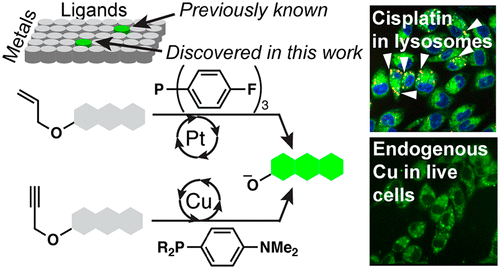当前位置:
X-MOL 学术
›
ACS Cent. Sci.
›
论文详情
Our official English website, www.x-mol.net, welcomes your
feedback! (Note: you will need to create a separate account there.)
Using Ligand-Accelerated Catalysis to Repurpose Fluorogenic Reactions for Platinum or Copper
ACS Central Science ( IF 12.7 ) Pub Date : 2020-09-18 , DOI: 10.1021/acscentsci.0c00676 Dianne Pham 1 , Carly J. Deter 1 , Mariah C. Reinard 1 , Gregory A. Gibson 2 , Kirill Kiselyov 3 , Wangjie Yu 4 , Vlad C. Sandulache 4 , Claudette M. St. Croix 2 , Kazunori Koide 1
ACS Central Science ( IF 12.7 ) Pub Date : 2020-09-18 , DOI: 10.1021/acscentsci.0c00676 Dianne Pham 1 , Carly J. Deter 1 , Mariah C. Reinard 1 , Gregory A. Gibson 2 , Kirill Kiselyov 3 , Wangjie Yu 4 , Vlad C. Sandulache 4 , Claudette M. St. Croix 2 , Kazunori Koide 1
Affiliation

|
The development of a fluorescent probe for a specific metal has required exquisite design, synthesis, and optimization of fluorogenic molecules endowed with chelating moieties with heteroatoms. These probes are generally chelation- or reactivity-based. Catalysis-based fluorescent probes have the potential to be more sensitive; however, catalytic methods with a biocompatible fluorescence turn-on switch are rare. Here, we have exploited ligand-accelerated metal catalysis to repurpose known fluorescent probes for different metals, a new approach in probe development. We used the cleavage of allylic and propargylic ethers as platforms that were previously designed for palladium. After a single experiment that combinatorially examined >800 reactions with two variables (metal and ligand) for each ether, we discovered a platinum- or copper-selective method with the ligand effect of specific phosphines. Both metal–ligand systems were previously unknown and afforded strong signals owing to catalytic turnover. The fluorometric technologies were applied to geological, pharmaceutical, serum, and live cell samples and were used to discover that platinum accumulates in lysosomes in cisplatin-resistant cells in a manner that appears to be independent of copper distribution. The use of ligand-accelerated catalysis may present a new blueprint for engineering metal selectivity in probe development.
中文翻译:

使用配体加速催化将氟反应重新用于铂或铜
用于特定金属的荧光探针的开发需要精心设计,合成和优化赋予具有杂原子螯合部分的荧光分子。这些探针通常基于螯合或反应性。基于催化的荧光探针可能具有更高的灵敏度。然而,具有生物相容性荧光开启开关的催化方法很少。在这里,我们利用配体促进的金属催化将已知的荧光探针重新用于不同的金属,这是探针开发的一种新方法。我们使用烯丙基和炔丙基醚的裂解作为先前设计用于钯的平台。经过一个单独的实验,该实验组合地检查了> 800个反应,每个醚有两个变量(金属和配体),我们发现了具有特定膦配体作用的铂或铜选择性方法。以前都不知道这两种金属-配体系统,并且由于催化转换而提供了强烈的信号。荧光技术已应用于地质,药物,血清和活细胞样品,并用于发现铂在顺铂耐药细胞中的溶酶体中蓄积,其方式似乎与铜的分布无关。配体加速催化的使用可能为探针开发中工程金属选择性提供新的蓝图。和活细胞样品,并用于发现铂在顺铂耐药细胞中的溶酶体中蓄积,其方式似乎与铜的分布无关。配体加速催化的使用可能为探针开发中工程金属选择性提供新的蓝图。和活细胞样品,并用于发现铂在顺铂耐药细胞中的溶酶体中蓄积的方式似乎与铜的分布无关。配体加速催化的使用可能为探针开发中工程金属选择性提供新的蓝图。
更新日期:2020-10-29
中文翻译:

使用配体加速催化将氟反应重新用于铂或铜
用于特定金属的荧光探针的开发需要精心设计,合成和优化赋予具有杂原子螯合部分的荧光分子。这些探针通常基于螯合或反应性。基于催化的荧光探针可能具有更高的灵敏度。然而,具有生物相容性荧光开启开关的催化方法很少。在这里,我们利用配体促进的金属催化将已知的荧光探针重新用于不同的金属,这是探针开发的一种新方法。我们使用烯丙基和炔丙基醚的裂解作为先前设计用于钯的平台。经过一个单独的实验,该实验组合地检查了> 800个反应,每个醚有两个变量(金属和配体),我们发现了具有特定膦配体作用的铂或铜选择性方法。以前都不知道这两种金属-配体系统,并且由于催化转换而提供了强烈的信号。荧光技术已应用于地质,药物,血清和活细胞样品,并用于发现铂在顺铂耐药细胞中的溶酶体中蓄积,其方式似乎与铜的分布无关。配体加速催化的使用可能为探针开发中工程金属选择性提供新的蓝图。和活细胞样品,并用于发现铂在顺铂耐药细胞中的溶酶体中蓄积,其方式似乎与铜的分布无关。配体加速催化的使用可能为探针开发中工程金属选择性提供新的蓝图。和活细胞样品,并用于发现铂在顺铂耐药细胞中的溶酶体中蓄积的方式似乎与铜的分布无关。配体加速催化的使用可能为探针开发中工程金属选择性提供新的蓝图。









































 京公网安备 11010802027423号
京公网安备 11010802027423号